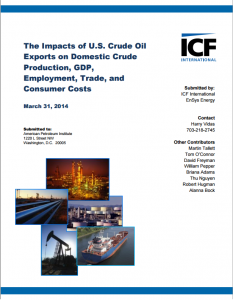Full Title: The Impacts of U.S. Crude Oil Exports on Domestic Crude Production, GDP, Employment, Trade, and Consumer Costs
Author(s): Martin Tallett, Tom O’Connor, David Freyman, William Pepper, Briana Adams, Thu Nguyen, Robert Hugman, and Alanna Bock
Publisher(s): ICF International
Publication Date: March 1, 2014
Full Text: Download Resource
Description (excerpt):
API asked ICF International (in cooperation with EnSys Energy) to conduct a study of the economic impacts of changing U.S. government policies that prohibit most export of U.S. crude oils. This study provides an analysis of the impacts of a liberalized crude export policy.
The United States government restricted the export of most domestically produced crude oil starting in 1973, a time when U.S. oil production was in decline. In recent years, the oil and gas industry reversed the downward crude oil production trajectory through a technological revolution. Horizontal well drilling and multi-stage hydraulic fracturing are now utilized to access oil and gas resources that were previously either technically impossible or uneconomic to produce. Between 2009 and 2013, U.S. crude oil production has increased by 2.1 million barrels per day (MMBPD) (39 percent) and is projected to increase another 3.2–3.3 MMBPD through 2020, according to ICF/EnSys estimates. Forecasts of substantial near-term production increases have also been made by the U.S. Energy Information Administration (1.8 MMBPD increase from 2013 to 2020) and other forecasts cited later in this report.
This production revolution has fundamentally altered the domestic flow of crude oil, with states such as North Dakota and Texas now producing substantial volumes of tight oil.6 The new oil supplies, made up primarily of light sweet crude oil and lease condensate, are concentrated in the Bakken (MT, ND), Niobrara (CO, WY), Permian (NM, TX), and Eagle Ford (TX) shale plays, as shown in the exhibit below.
